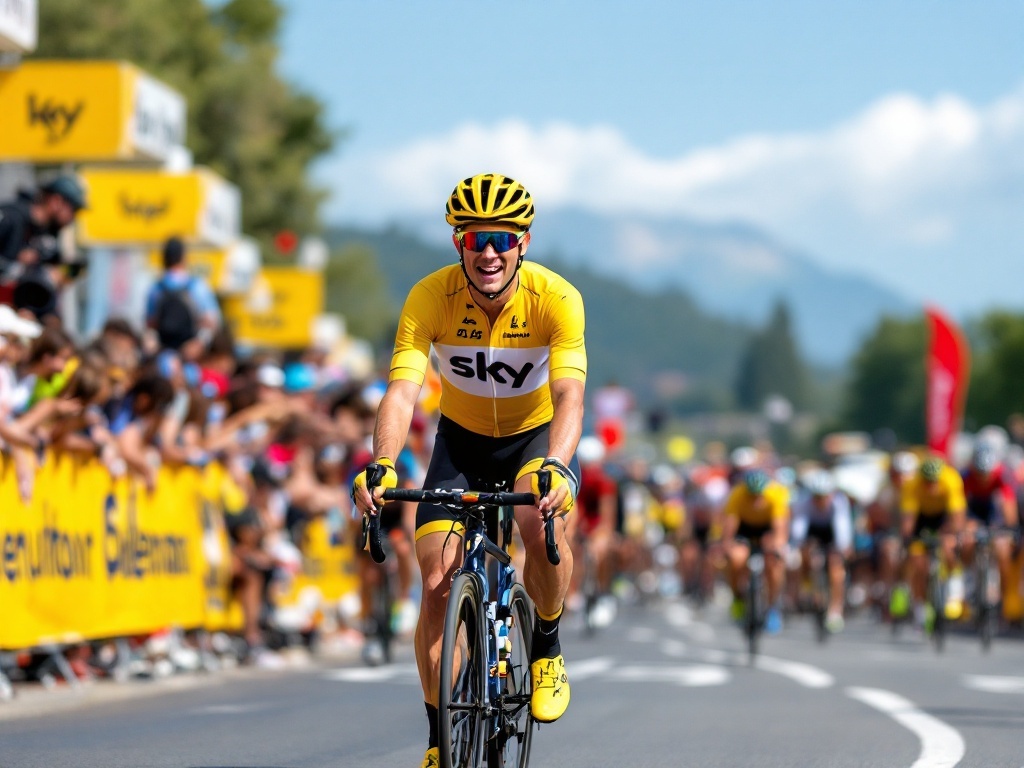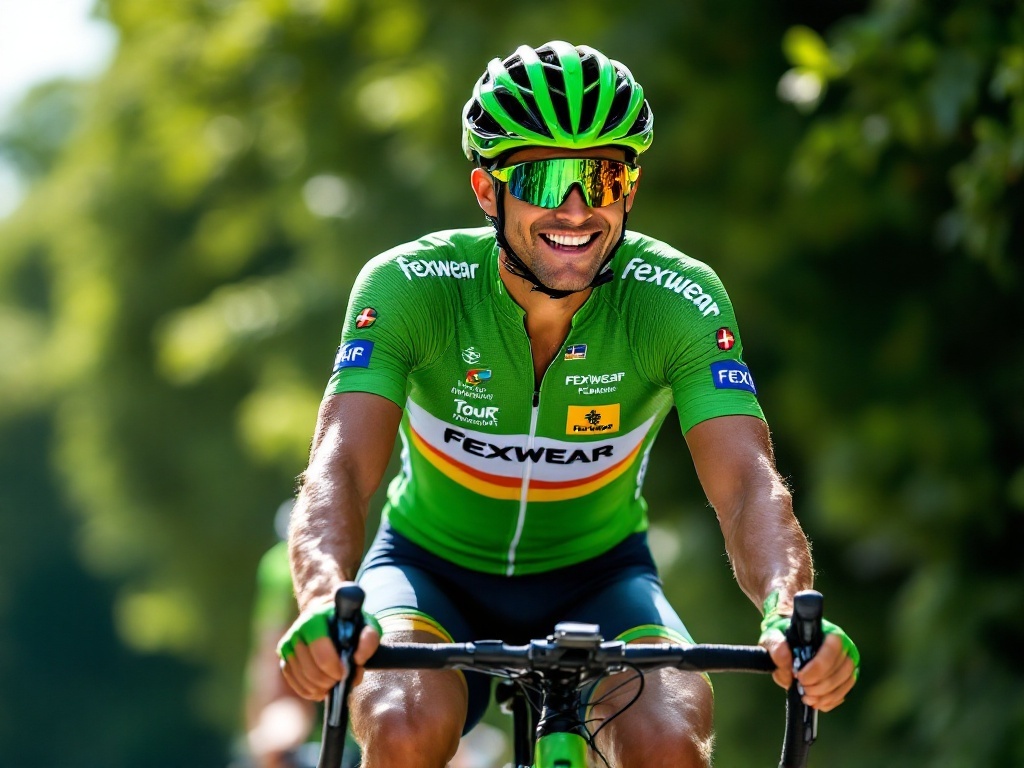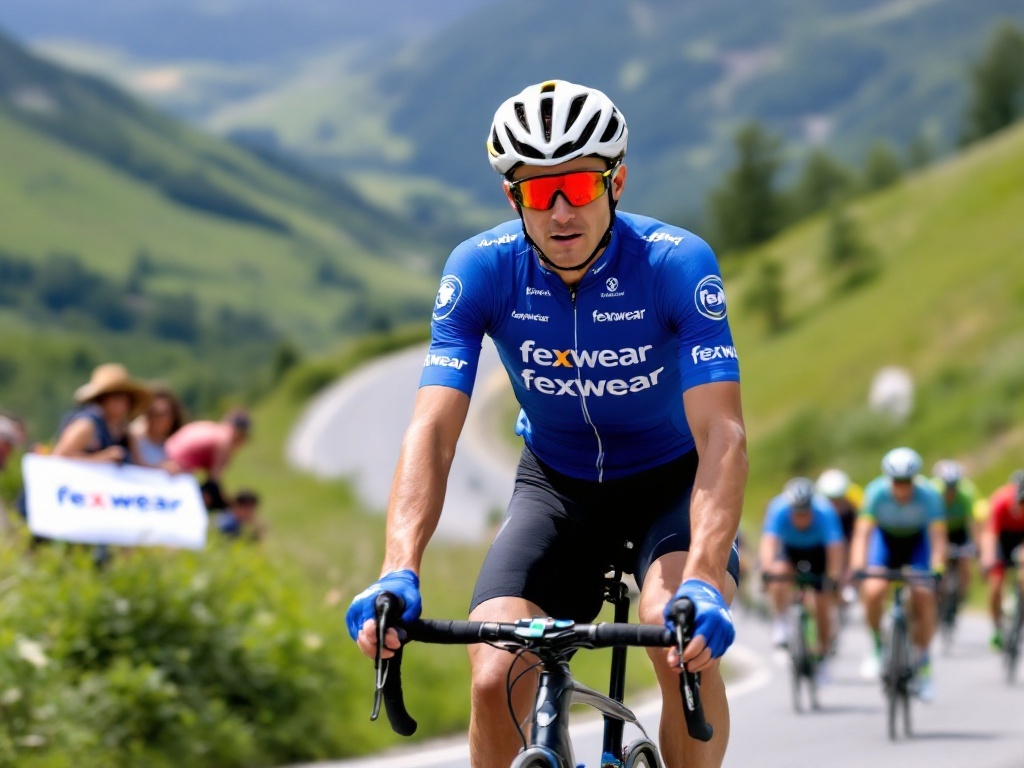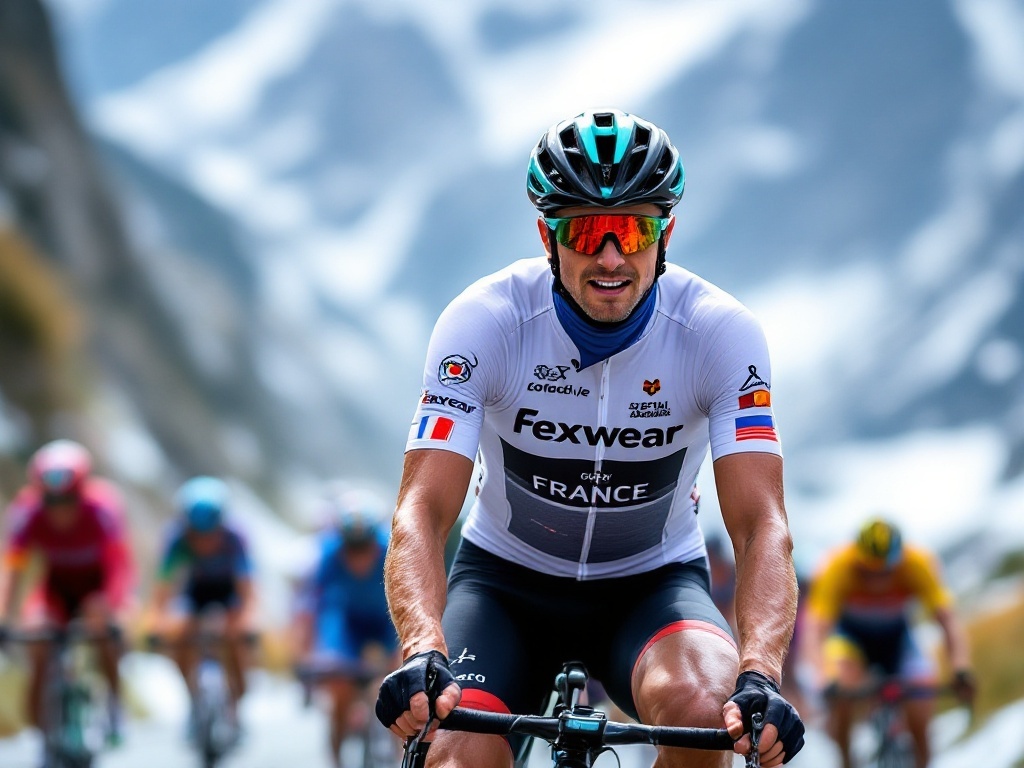Have you ever been curious about the vibrant cycling jerseys that competitors wear during events like the Tour de France or Giro d’Italia? Each hue—be it the iconic yellow, the striking green, or the lively polka dots—carries a deeper significance beyond mere aesthetics. It represents a cyclist’s achievements, grit, and tactics. As you follow the race, each jersey seems to narrate its own tale of struggle and triumph. Let’s delve into the meanings behind these jerseys, beginning with the most prestigious.
Yellow Jersey (Maillot Jaune)
The yellow jersey, known as the maillot jaune, is more than just an accolade—it symbolizes superiority in cycling. It is awarded to the rider who has accumulated the fastest overall time across all stages. This jersey is the most sought-after prize, donned by the current leader of the race. However, it’s important to note that winning a stage doesn’t guarantee the yellow jersey; what counts is the cumulative time throughout the entire competition, not just one day’s performance.

History and Significance
- The yellow jersey was first introduced in 1919 by the organizers of the Tour de France, inspired by the yellow paper used in the newspaper “L’Auto.” The choice of color aimed to enhance the leader’s visibility in the peloton.
- This jersey signifies the pinnacle of achievement in the Tour de France, indicating who holds the title of the current leader of the race.
Notable Winners
- 2023: Jonas Vingegaard (Team Jumbo–Visma)
- 2022: Jonas Vingegaard (Team Jumbo–Visma)
- 2021: Tadej Pogačar (UAE Team Emirates)
- 2020: Tadej Pogačar (UAE Team Emirates)
- 2019: Egan Bernal (Team Ineos)
The yellow jersey remains one of cycling’s most iconic symbols, reflecting the rider’s skill and perseverance over the challenging stages.
Green Jersey (Maillot Vert) – Tour de France Jerseys
The green cycling jersey (maillot vert) represents honor for the cyclist leading the points classification in the Tour de France. This accolade is the ultimate prize for sprinters, but it encompasses more than just speed. Riders must excel in climbs and recover swiftly. Every stage tests their power and endurance, merging thrilling sprints with the rigors of recovery.

Points Distribution
- Flat stages: The winner earns 50 points.
- Hilly and mountain stages: The victor typically receives 20 points.
- Intermediate sprints: Points are available at designated intermediate sprint points during stages, with breakaway riders leveraging these opportunities.
Points Scheme and Stage Types
- Flat stages: Yield the highest points, awarding 50 points to the winner.
- Hilly and mountain stages: Offer fewer points, promoting consistent performance across varied terrains.
Tiebreakers
- In case of a tie, the cyclist with the most stage victories takes precedence.
- If stage wins are equal, intermediate sprint victories determine the leader.
- If still tied, the general classification serves as the final tiebreaker.
Historical Winners
- Peter Sagan holds the record with seven wins (2012-2019).
- Erik Zabel previously held the record with six consecutive victories (1996-2001).
Introduction and Color Change
- The green jersey debuted in 1953, with Fritz Schär as its inaugural recipient.
- It briefly shifted to red in 1968 due to sponsorship but reverted to its classic green in 1969.
Red Polka Dot Jersey (Maillot à Pois Rouges) – Tour de France Jerseys
The Red Polka Dot Jersey is not just a garment; it symbolizes achievement. Awarded to the top climber in the Tour de France, this jersey reflects a rider’s mastery over challenging ascents, demonstrating their physical limits. Each point earned is a testament to their strenuous efforts, marking them as the mountain conqueror.

Points System for the Red Polka Dot Jersey
Points are awarded based on a rider’s position at the summit of designated climbs. The severity of each ascent dictates the points received, categorized as follows:
- Hors Catégorie (HC): The steepest climbs, offering the most points. The first rider to summit can earn up to 40 points, with points decreasing for subsequent riders. HC climbs are crucial for amassing points.
- Category 1: These climbs provide fewer points than HC climbs, yet still yield substantial rewards for the top six riders.
- Category 2: Points are granted to the first four riders reaching the top.
- Category 3: The top three riders claim points for these climbs.
- Category 4: Only the first rider to reach the top receives points.
Summit Finishes and Tiebreaker
- Summit finishes are vital as they double the points awarded for that specific climb.
- If two riders are tied in points, the tiebreaker is decided by the number of first-place finishes on HC climbs or summit finishes, favoring the rider with the most victories on these climbs.
Key Climbs for the Red Polka Dot Jersey
Stages featuring renowned climbs such as Col du Granon and Alpe d’Huez are pivotal in determining the winner of the red polka dot jersey. These ascents offer substantial points, essential for riders vying for the mountains classification.
White Jersey (Maillot Blanc) – Tour de France Jerseys
The maillot blanc is a white jersey awarded to the leading cyclist under 26 years old in the Tour de France. Introduced in 1975, it celebrates the sport’s emerging talents. This jersey allows young cyclists to shine among seasoned competitors, embodying youthful aspirations and the promise of future triumphs.

Purpose of the White Jersey
The white jersey highlights the ability and potential of young riders in the Tour de France. For many, wearing the white jersey is as prestigious as clinching the yellow jersey, which is bestowed upon the overall race leader. It illuminates the rising stars in the cycling world.
Recent Winners of the White Jersey
- 2022: Tadej Pogačar
- 2021: Tadej Pogačar
- 2020: Tadej Pogačar
- 2019: Egan Bernal
- 2018: Pierre Latour
Tadej Pogačar has been exceptional in this category, securing the white jersey three consecutive years (2020-2022), often coinciding with his overall race victories.
History of the White Jersey
The first cyclist to win the white jersey under the revised youth classification was Francesco Moser, an Italian competitor.
Pink Jersey (Maglia Rosa) – Giro d’Italia Jerseys
The pink jersey (Maglia Rosa) is donned by the leader of the general classification in the Giro d’Italia, showcasing the rider who has navigated the course fastest, asserting their dominance in the race.

History and Origins
The pink jersey was established in 1931 by Armando Cougnet, a journalist from La Gazzetta dello Sport, the Italian newspaper that founded the Giro d’Italia. The color pink was chosen due to the newspaper’s pink paper, making it a fitting choice for the jersey’s design.
Notable Milestones
- Learco Guerra was the first cyclist to wear the Maglia Rosa in 1931 after triumphing in the opening stage from Milan to Mantova.
- Eddy Merckx holds the record for most days in the pink jersey, with 78 days. He is followed by Francesco Moser (57 days) and Gino Bartali (50 days).
Jersey Evolution
Originally made from wool, the jersey is now crafted from lightweight lycra, enhancing both comfort and performance for riders. The design has gradually incorporated sponsor logos and modern elements, yet retains its distinctive pink color and traditional appearance.
Strategic Importance
- Wearing the Maglia Rosa brings tactical pressure, as the leader and their team face constant challenge from competitors.
- The pink jersey symbolizes excellence, resilience, and strategic brilliance, marking the pinnacle of achievement in professional cycling.
Purple/Cyclamen Jersey (Maglia Ciclamino) – Giro d’Italia Jerseys
The Maglia Ciclamino, or purple cyclamen jersey, is awarded to the leader of the points classification in the Giro d’Italia. This classification was introduced in 1966 and is the third oldest of the four major jersey categories in the race.
Points System
Points are earned based on stage finishes and intermediate sprints:
- Flat stages and intermediate sprints yield higher points, favoring sprinters.
- Stage categories have distinct point allocations:
- A and B category stages: 50, 35, 25, 18, 14, 12, 10, 8, 7, 6, 5, 4, 3, 2, 1 points.
- Cima Coppi (highest peak): 50, 30, 20, 14, 10, 6, 4, 2, 1 points.
- First-category summit finishes: 50, 24, 16, 9, 6, 4, 2, 1 points.
- First-category climbs: 40, 18, 12, 9, 6, 4, 2, 1 points.
- Second-category climbs: 18, 8, 6, 4, 2, 1 points.
- Third-category climbs: 9, 4, 2, 1 points.
- Fourth-category climbs: 3, 2, 1 points.
Tiebreaker and Recent Examples
In the event of a tie, Cima Coppi and first-place finishes on first-category climbs are used to break the tie. The rider with the highest total points at the conclusion of the Giro d’Italia wins the points competition and claims the Maglia Ciclamino. In the 2024 Giro d’Italia, Jonathan Milan led the points classification with 352 points.
Blue Jersey (Maglia Azzurra) – Giro d’Italia Jerseys
The blue jersey (maglia azzurra) is awarded to the cyclist leading the mountains classification in the Giro d’Italia. This jersey signifies the top climber in the race.

Purpose of the Blue Jersey
The rider wearing the blue jersey has accrued the most points from classified climbs. These ascents, ranging from minor hills to towering peaks, are critical moments in the race, often favoring strong climbers and those adept at breakaway tactics.
Classification History
- The mountains classification has been part of the Giro since 1933.
- From 1974 to 2011, the leader wore a green jersey (maglia verde).
- In 2012, following a sponsorship deal with Banca Mediolanum, the jersey transitioned to blue.
Climb Categories & Points
Climbs are ranked by difficulty, with points allocated based on the category:
- Cima Coppi: 50, 30, 20, 14, 10, 6, 4, 2, 1 points (highest point of the race)
- First Category: 40, 18, 12, 9, 6, 4, 2, 1 points
- First Category Summit Finishes (since 2023): 50, 24, 16, 9, 6, 4, 2, 1 points
- Second Category: 18, 8, 6, 4, 2, 1 points
- Third Category: 9, 4, 2, 1 points
- Fourth Category: 3, 2, 1 points
Recent Winners
- 2023: Thibaut Pinot
- 2022: Koen Bouwman
- 2021: Geoffrey Bouchard
- 2020: Ruben Guerreiro
- 2019: Giulio Ciccone
- 2018: Chris Froome
- 2017: Mikel Landa
- 2016: Mikel Nieve
- 2015: Giovanni Visconti
- 2014: Julián David Arredondo
- 2013: Stefano Pirazzi
White Jersey (Maglia Bianca) – Giro d’Italia Jerseys

The white jersey (maglia bianca) in the Giro d’Italia is presented to the best young rider in the race. Here are the key details:
- The maglia bianca is awarded to the youngest rider with the fastest overall time, as long as they are under 25 years old at the beginning of the year in which the race occurs.
- This classification parallels the Tour de France’s white jersey, but with a slight age difference: the Giro’s cutoff is 25 years old, while the Tour allows riders up to 26 years old.
- The jersey is awarded daily to the rider with the lowest cumulative time in the general classification.
- If a rider leads in multiple classifications, jersey priority follows this order: pink (maglia rosa), purple (maglia ciclamino), blue (maglia azzurra), and finally white (maglia bianca).
- Riders sporting the maglia bianca also receive a monetary award, which in certain editions included 100 lire per day.
Historical Context and Importance of the White Jersey
The white jersey celebrates the emerging stars of the sport, motivating young cyclists to showcase their abilities. While it may not hold the same prestige as the maglia rosa or maglia ciclamino, it remains a significant milestone in a young cyclist’s career.
The blue jersey, or maglia azzurra, signifies more than just a color. It represents a rider who excels in the mountains with every challenging ascent. When a cyclist dons this jersey in the Giro d’Italia, it reflects their strength and determination to conquer greater heights and distances than their competitors. It symbolizes the race’s premier climber, a true mountain champion.
Summary
These jerseys are not merely colorful garments; they encapsulate the effort, strategy, and spirit of cycling’s premier competitions. The yellow jersey and the white jersey each symbolize a unique form of excellence. For cyclists, these jerseys represent hard work, dreams, and the relentless pursuit of pushing human limits.
For more information, visit fexwear.com.
